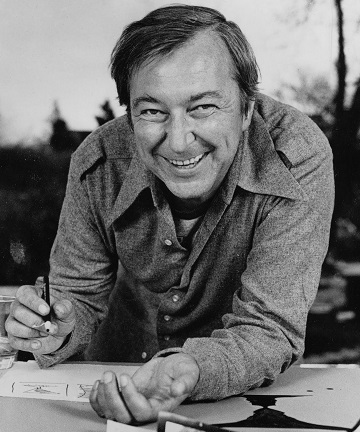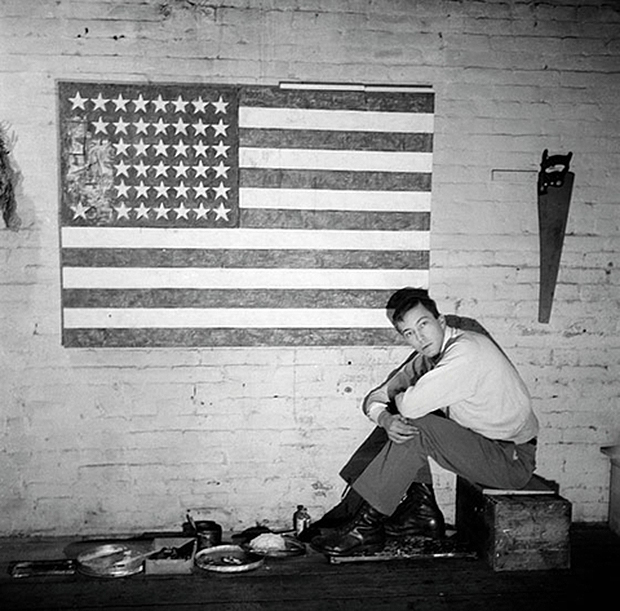Discovering the Artist
Jasper Johns
You have two assignments: the reading and assessment and the assignment to create your own symbolic flag below.
Jasper Johns
The artist Jasper Johns (1930-) was one of the early artists that sought to discover a new visual language. He sought to do this through taking every day objects and symbols and presenting them as works of art unto themselves. His first and most important works were by taking the American flag and forcing the public to see it in a different light. As a painting he placed the symbol in a different context. This took place during the Vietnam war, America was indifferent, mostly against the war. It would be the first major war that America would lose or walk away from. In essence the flag had moral stains on it, not to mention the genocide of the American Indian and the bondage of slavery. He presents a flag that is dirty and worn as if it represented a conflicted and disturbed individual portrait.
When you stand in a mirror in the morning look at yourself, not as a human being but as a symbol of something, What would that symbol or symbols look like?
Jasper Johns at Pearl Street studio in 1955. Photograph by Robert Rauschenberg
As the art world was searching for new ideas, outside the purely abstract style, the early paintings of maps and flags which Jasper Johns created, took in both praise and ridicule by certain critics in the art world. The early works he created, had a sense of craft work, and a small expression of the extra-ordinary and absurd. The process to create the images, were the meanings were found. Much of the work Jasper Johns created, was extremely new to the museum goers and art lovers, as the simple form of designing flags, and large numbers in print, was something which was never seen before. The distinct style, and the simplicity behind it, eventually captured the interest of museum goers.
Just as Jean Michel Basquiet would create late in the 1970’s, Jasper John produced in the late 1950’s. He took everyday objects and symbols and transformed them into a whole new language as he did in these two paintings depicting a target and the number 8.
Johns is one of most significant and influential American painters of the twentieth century. He also ranks with Rembrandt, Francisco Goya, Edvard Munch, and Picasso as one of the greatest printmakers of any era. In addition, he makes many drawings - unique works on paper, usually based on a painting he has previously painted - and he has created an unusual body of sculptural objects.
To be an artist you have to give up everything, including the desire to be a good artist.”
-Jasper Johns
Paintings of everyday symbols by Jasper Johns
Over this 50 year career, Jasper Johns created his own distinct style, and a vast series of pieces. Not only were they ahead of their time, he led artists to a new transition of work as well. And, to this day, his works were sold for some of the highest price tags in the art world, especially as a living artist.
“In the early 1950s, while working closely with Robert Rauschenberg in adjacent lofts in lower Manhattan, Johns resolved to be an artist. With this novel sense of determination, Johns did two things that would help establish his identity and significance as an artist. First, he systematically destroyed all existing work in his possession, vowing that henceforth his art would be free of perceptible debt to other artists. Secondly, he painted Flag, a curiously mature work inspired by a dream in which he saw himself painting an American flag. Moderate in scale it has none of the visionary qualities one might expect given its purported origins in the artist’s unconscious.
"Perhaps most obviously, Flag serves to question what a painting is, and how it is to be differentiated from the object it represents. Is Flag a painting or a flag, or both? Flag does not conclusively answer that question; instead, like so many of Johns’s creations it establishes a line of inquiry and asserts its significance for the practice and history of art.
“A close look at Flag’s surface confirms that Johns shared his contemporaries’ interest in the material properties of paint. In most other respects, however, Flag stood apart from its context: in an era that prized abstraction, Johns chose recognizable, commonplace subject matter.”
“Flag is covered with a lush array of drips and fleshy brushstrokes, initially confirming Johns’s kinship with mid-century American painting. Yet Johns’s motif and technique tell a different story – one of endings and beginnings, and the passage that comes in between. Begun in the fashionable medium of oil-based enamel paint, Flag was completed using the anachronistic medium of encaustic in which pigment is mixed with hot wax and, in Flag’s case, strips of newspaper and fabric to which the coloured encaustic adhered. As Johns explained it, encaustic allowed him to be more efficient and, at the same time, more deliberate in his gestures. In other words, because pigmented wax sets quickly, Johns could add another mark or strip of saturated paper or cloth with the assurance that any previously laid marks would remain unaffected. In this way, each discrete trace was preserved, effectively embalmed.
Statue of William Jasper on Maidson Square in Savannah, GA
“Although Johns was loath to admit it, something else was preserved in Flag too. For while it established his reputation as an artist and delivered him from his origins in the agrarian South, it also affirmed the influence of these roots on his thinking. As the artist belatedly revealed in an interview in 1990. "In Savannah, Georgia, in a park, there is a statue of Sergeant William Jasper. Once I was walking through this park with my father, and he said that we were named for him. Whether or not that is in fact true or not, I don’t know. Sergeant Jasper lost his life raising the American flag over a fort.’”
Assignment:
Create a Symbolic Flag
Create your own personal flag. Using a simple piece of paper and color pencils experiment with first creating a logo using your initial caps of your name. Place your logo where the stars would go in the American flag. Next, add your stripes. How many will you add and what do they represent? The amount of your family? Your age. etc.? What colors will you choose for your stripes and logo? What do they represent? At the bottom of your flag explain your flag with regards to its design.







